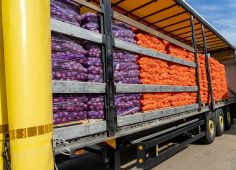GMO Labeling Laws per Country
By Mae Margaret Macahilo
Genetically engineered food has been a controversial issue in the food industry. Opinions are divided as to whether genetically modified foods are harmful or not. Due to the lack of concrete evidence proving that genetically modified foods are indeed detrimental to health, many countries do not have mandatory GMO labeling laws in place.
GMO Labeling Laws
If you look at the table below, only three countries implement a complete and total ban of genetically engineered (GE) food both imported and cultivated. Most of the countries in the EU region, Australia and New Zealand implement mandatory labeling with up to 1% labeling threshold of GMO content.
Some Asian countries, Brazil, South Africa and Ukraine also implement mandatory food labeling on many of their GE foods but with higher threshold for GMO content.
Many Asian and Latin American countries as well as some African countries have their labeling law on some GE foods but with numerous exception. They also do not implement a labeling threshold on GMO content.
| Country | Labelling Law | Labeling Threshold |
| Benin | Official ban on GE food imports and cultivation |
0 threshold |
| Serbia | Official ban on GE food imports and cultivation |
0 threshold |
| Zambia | Official ban on GE food imports and cultivation |
0 threshold |
| Canada | No GE food labeling laws | N/A |
| Mexico | No GE food labeling laws | N/A |
| United States | No GE food labeling laws | N/A |
| Australia | Mandatory labeling of nearly all GE foods | 0.9 – 1% GMO content |
| Austria | Mandatory labeling of nearly all GE foods | 0.9 – 1% GMO content |
| Belarus | Mandatory labeling of nearly all GE foods | 0.9 – 1% GMO content |
| Belgium | Mandatory labeling of nearly all GE foods | 0.9 – 1% GMO content |
| Bosnia and Herzegovina | Mandatory labeling of nearly all GE foods | 0.9 – 1% GMO content |
| Bulgaria | Mandatory labeling of nearly all GE foods | 0.9 – 1% GMO content |
| Croatia | Mandatory labeling of nearly all GE foods | 0.9 – 1% GMO content |
| Cyprus | Mandatory labeling of nearly all GE foods | 0.9 – 1% GMO content |
| Czech Republic | Mandatory labeling of nearly all GE foods | 0.9 – 1% GMO content |
| Denmark | Mandatory labeling of nearly all GE foods | 0.9 – 1% GMO content |
| Estonia | Mandatory labeling of nearly all GE foods | 0.9 – 1% GMO content |
| Finland | Mandatory labeling of nearly all GE foods | 0.9 – 1% GMO content |
| France | Mandatory labeling of nearly all GE foods | 0.9 – 1% GMO content |
| Germany | Mandatory labeling of nearly all GE foods | 0.9 – 1% GMO content |
| Greece | Mandatory labeling of nearly all GE foods | 0.9 – 1% GMO content |
| Hungary | Mandatory labeling of nearly all GE foods | 0.9 – 1% GMO content |
| Iceland | Mandatory labeling of nearly all GE foods | 0.9 – 1% GMO content |
| Ireland | Mandatory labeling of nearly all GE foods | 0.9 – 1% GMO content |
| Italy | Mandatory labeling of nearly all GE foods | 0.9 – 1% GMO content |
| Kazakhstan | Mandatory labeling of nearly all GE foods | 0.9 – 1% GMO content |
| Latvia | Mandatory labeling of nearly all GE foods | 0.9 – 1% GMO content |
| Lithuania | Mandatory labeling of nearly all GE foods | 0.9 – 1% GMO content |
| Luxembourg | Mandatory labeling of nearly all GE foods | 0.9 – 1% GMO content |
| Malta | Mandatory labeling of nearly all GE foods | 0.9 – 1% GMO content |
| Netherlands | Mandatory labeling of nearly all GE foods | 0.9 – 1% GMO content |
| New Zealand | Mandatory labeling of nearly all GE foods | 0.9 – 1% GMO content |
| Norway | Mandatory labeling of nearly all GE foods | 0.9 – 1% GMO content |
| Poland | Mandatory labeling of nearly all GE foods | 0.9 – 1% GMO content |
| Portugal | Mandatory labeling of nearly all GE foods | 0.9 – 1% GMO content |
| Romania | Mandatory labeling of nearly all GE foods | 0.9 – 1% GMO content |
| Russia | Mandatory labeling of nearly all GE foods | 0.9 – 1% GMO content |
| Saudi Arabia | Mandatory labeling of nearly all GE foods | 0.9 – 1% GMO content |
| Slovakia | Mandatory labeling of nearly all GE foods | 0.9 – 1% GMO content |
| Slovenia | Mandatory labeling of nearly all GE foods | 0.9 – 1% GMO content |
| Spain | Mandatory labeling of nearly all GE foods | 0.9 – 1% GMO content |
| Sweden | Mandatory labeling of nearly all GE foods | 0.9 – 1% GMO content |
| Switzerland | Mandatory labeling of nearly all GE foods | 0.9 – 1% GMO content |
| Turkey | Mandatory labeling of nearly all GE foods | 0.9 – 1% GMO content |
| United Kingdom | Mandatory labeling of nearly all GE foods | 0.9 – 1% GMO content |
| Brazil | Mandatory labeling of many GE foods | 1% or higher or undefined GMO content |
| China | Mandatory labeling of many GE foods | 1% or higher or undefined GMO content |
| Indonesia | Mandatory labeling of many GE foods | 1% or higher or undefined GMO content |
| Japan | Mandatory labeling of many GE foods | 1% or higher or undefined GMO content |
| Kenya | Mandatory labeling of many GE foods | 1% or higher or undefined GMO content |
| Malaysia | Mandatory labeling of many GE foods | 1% or higher or undefined GMO content |
| South Africa | Mandatory labeling of many GE foods | 1% or higher or undefined GMO content |
| South Korea | Mandatory labeling of many GE foods | 1% or higher or undefined GMO content |
| Sri Lanka | Mandatory labeling of many GE foods | 1% or higher or undefined GMO content |
| Ukraine | Mandatory labeling of many GE foods | 1% or higher or undefined GMO content |
| Bolivia | Mandatory labeling of some GE foods with many exceptions | Not defined |
| Ecuador | Mandatory labeling of some GE foods with many exceptions | Not defined |
| India | Mandatory labeling of some GE foods with many exceptions | Not defined |
| Jordan | Mandatory labeling of some GE foods with many exceptions | Not defined |
| Mauritius | Mandatory labeling of some GE foods with many exceptions | Not defined |
| Peru | Mandatory labeling of some GE foods with many exceptions | Not defined |
| Senegal | Mandatory labeling of some GE foods with many exceptions | Not defined |
| Taiwan | Mandatory labeling of some GE foods with many exceptions | Not defined |
| Thailand | Mandatory labeling of some GE foods with many exceptions | Not defined |
| Tunisia | Mandatory labeling of some GE foods with many exceptions | Not defined |
| Vietnam | Mandatory labeling of some GE foods with many exceptions | Not defined |
Reference:
- http://www.centerforfoodsafety.org/ge-map/
- http://naturalsociety.com/breakdown-of-gmo-labeling-laws-by-country-global-map/
US GMO Labeling
US consumers have mixed opinions regarding GMO labeling. There is no mandated GMO labeling law in the US because the government believes that the nature of the product is more important than the production process. GM foods are seen to help eliminate food deserts, which are quickly becoming a problem in some US states.
US is the leading producer of GM foods. The government regulates GM foods similar to traditional ones, which keeps public safety, health and environmental safety in mind.
Canada GMO Labeling
Although a large number of Canadians wanted GM labeling in their country, the government has not made any significant move to implement mandatory GM labeling and establishing content thresholds. In fact, the Canadian government offered very minimal information regarding GM foods that some Canadians never even heard of them.
It’s not that Canada does not want a GM labeling in place. Rather, the government aims to prevent additional legal framework as well as possible duplication of regulatory agencies. Currently, Canada practices their existing regulations for their traditional products to GM foods.
EU GMO Labeling
EU has a clear and definite legal framework when it comes to GM labeling. Based on their evaluation report, their GM labeling legislation is effective in upholding both human and animal health. Despite the mandatory labeling and strict regulations set by the EU, NGOs, farmers, retailers and consumer organizations alike are satisfied with EU’s GM labeling legislation.
Official Ban GE Food Imports and Cultivation
Despite the massive food shortage, Zambia chooses to ban GM foods in their country. In fact, the government rejected 35,000 tons of food aid just because there is a possibility that it contain GM foods.
Serbia also imposes a total ban of GM food importation and cultivation in their country. Their geographical location makes it easier to impose such law because the EU is strict when it comes to GM foods. Serbia remains one of the top cultivators of GMO-free soy.
Benin is the third country to ban all GM foods in their country. The ban originally took place in 2002 and was further extended in 2008 to prevent importation, selling and use in the country. The total ban provides protection to its consumers and farmers alike while there is still no definite decision as to GMO’s impact on health and the environment.
About the Author
Mae Margaret Macahilo is a contributing writer to Food Quality Writer Works. She specializes in writing/blogging, SEO and keyword research, social media management, Internet research and data entry, management of WordPress sites, email list building and email marketing.
Note: This article is reprinted with the permission of Food Quality Magazine.
To have more articles like this emailed to your inbox, become a GFSR Member today!

-
 Supply Chain Management
Building a Safer Food System with Smart Supply Chain Strategies
Supply Chain Management
Building a Safer Food System with Smart Supply Chain Strategies
-
 Supply Chain Management
Driving Food Safety: The Role of Transportation Management Systems
Supply Chain Management
Driving Food Safety: The Role of Transportation Management Systems
- Podcast How Blockchain is Transforming the Food Industry: Perspectives from Ali Asgar Abbas, Co-Founder of ProofEasy
-
 Food Safety
The Realities of IPM: Challenges and Solutions for Pest Prevention in Food Safety
Food Safety
The Realities of IPM: Challenges and Solutions for Pest Prevention in Food Safety
- Podcast How Advanced Inspection Technology Can Transform Food Safety: Perspectives from Kye Luker
-
 FeaturedPublic Health
The Silent Invader: Uncovering H. pylori and Its Harmful Risks, Including Foodborne Illness
FeaturedPublic Health
The Silent Invader: Uncovering H. pylori and Its Harmful Risks, Including Foodborne Illness




